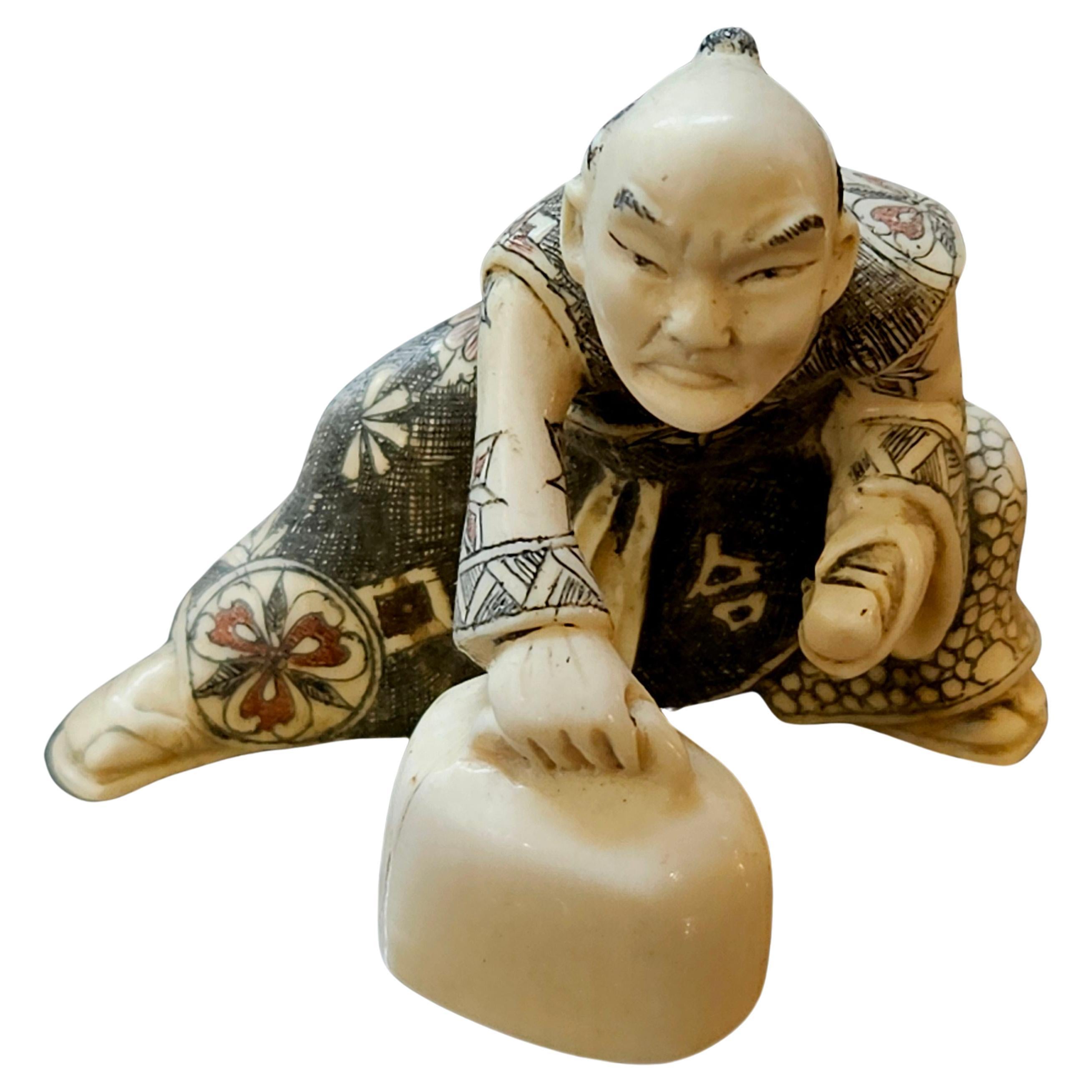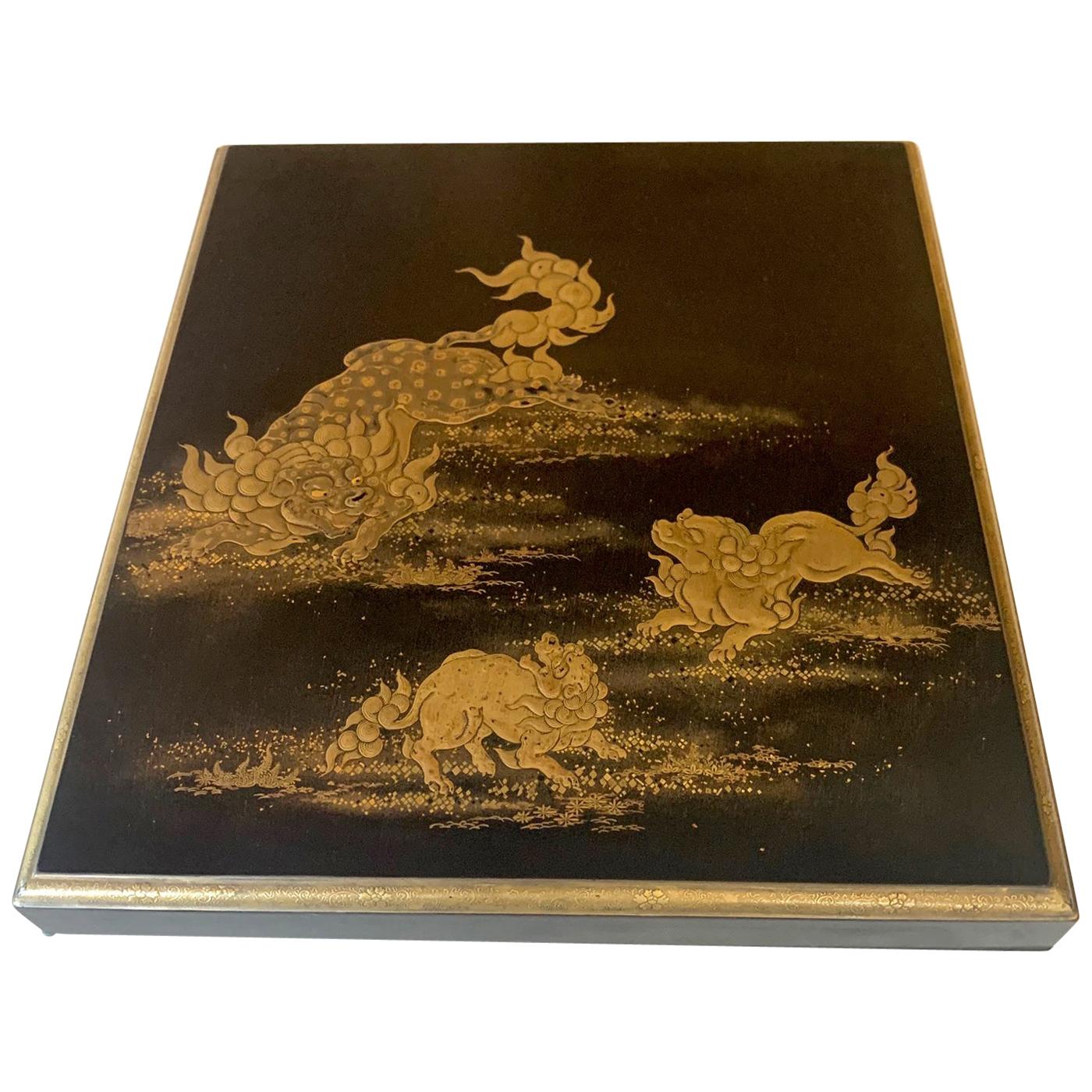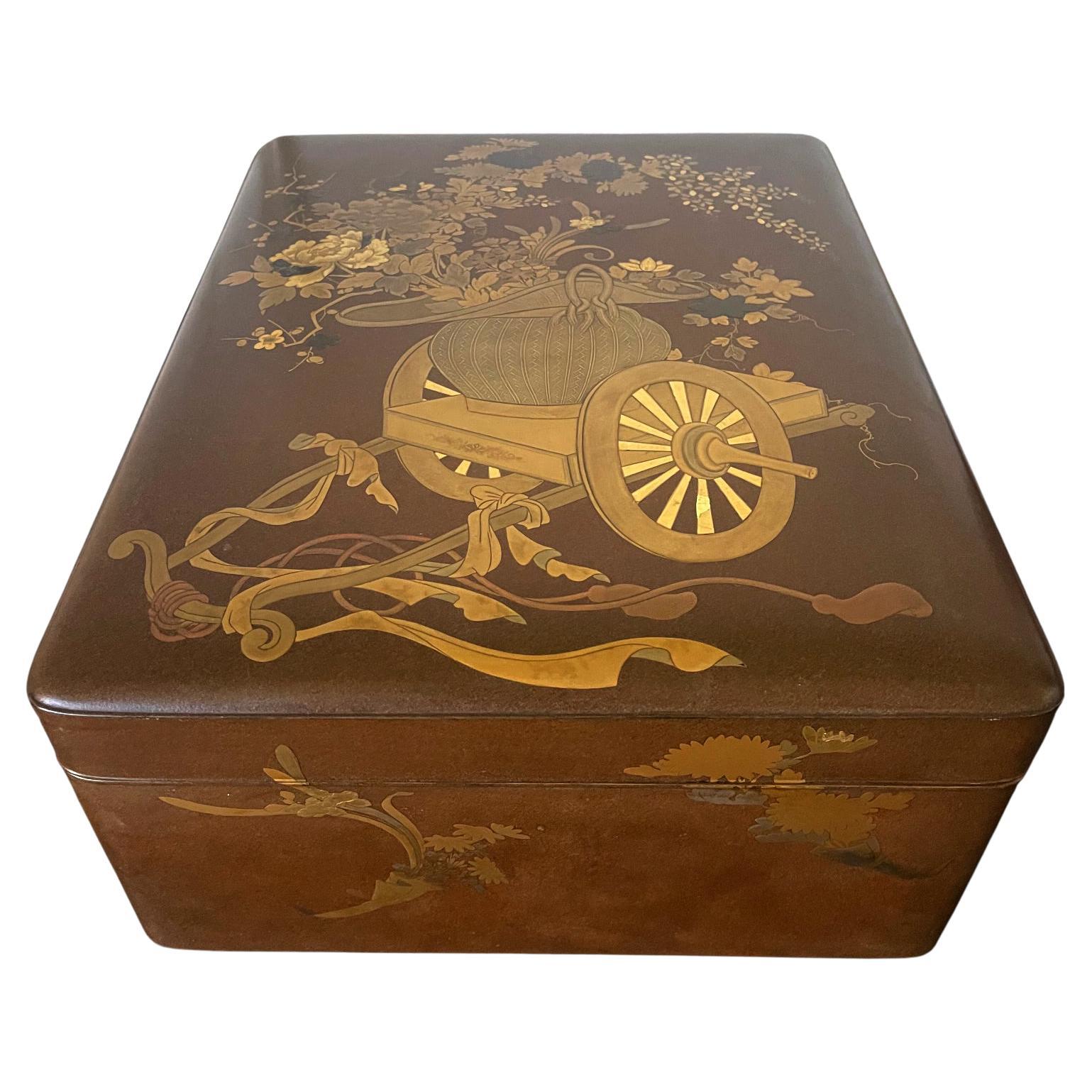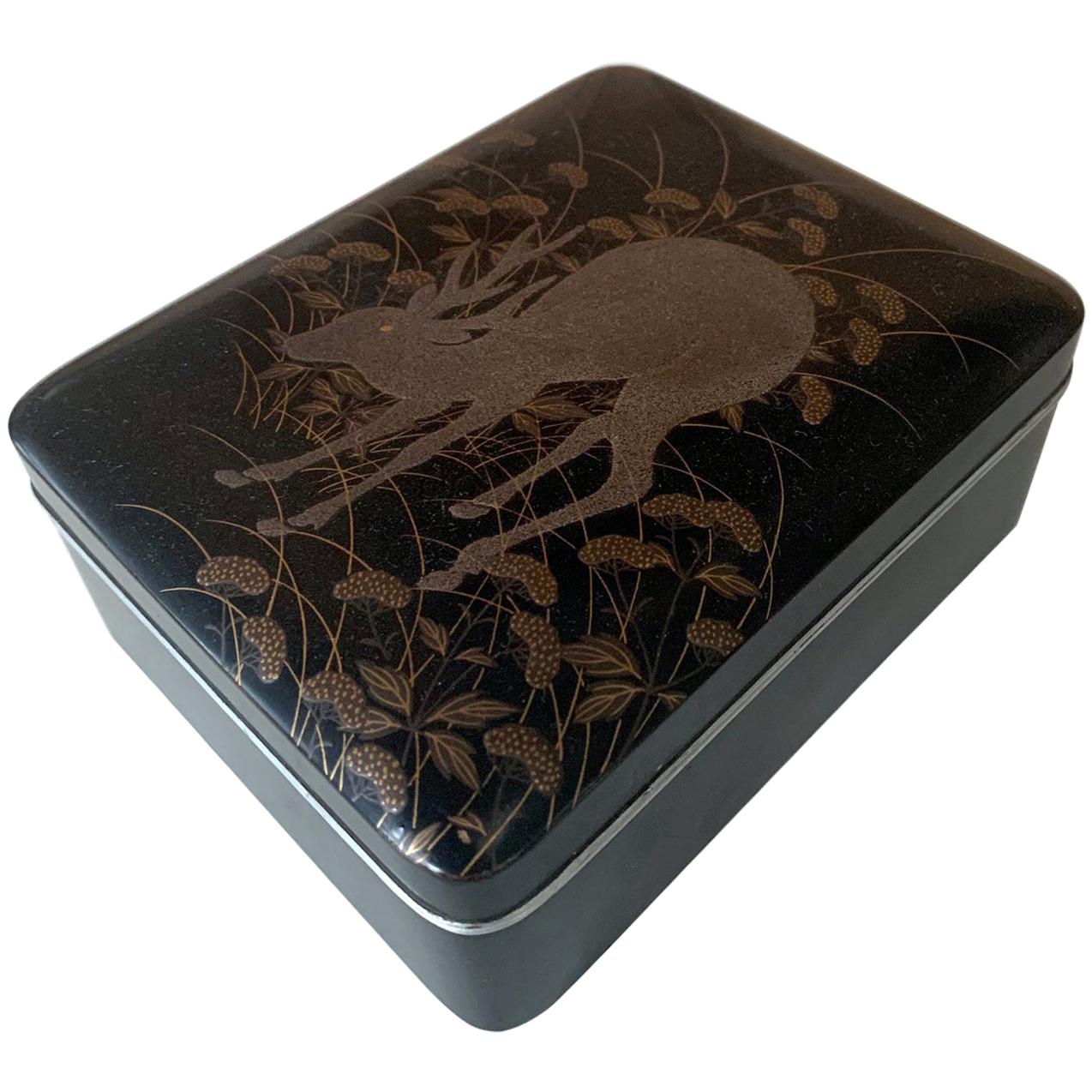Items Similar to Japanese Lacquer Inro with Netsuke Okame Mask Meiji Period
Want more images or videos?
Request additional images or videos from the seller
1 of 13
Japanese Lacquer Inro with Netsuke Okame Mask Meiji Period
About the Item
Japanese Lacquer Inro with Netsuke Okame Mask, brown lacquer with 3 sections and 2 compartments, and carved ivory polychrome Okame mask and a rope hair. This item is from the Meiji Period.
Dimension:
Inro: 1.5" W x 0.75" D x 1.25" H
Okame Mask: 0.5" x 0.75"
Condition: Good Condition.
Shipping Note: Ship to USA only, no international shipping.
- Dimensions:Height: 1.25 in (3.18 cm)Width: 1.5 in (3.81 cm)Depth: 0.75 in (1.91 cm)
- Materials and Techniques:
- Place of Origin:
- Period:
- Date of Manufacture:early 20th Century
- Condition:Wear consistent with age and use. Wear consistent with age and use.
- Seller Location:Norton, MA
- Reference Number:1stDibs: LU5848239674602
About the Seller
5.0
Platinum Seller
These expertly vetted sellers are 1stDibs' most experienced sellers and are rated highest by our customers.
Established in 2000
1stDibs seller since 2021
86 sales on 1stDibs
Typical response time: <1 hour
- ShippingRetrieving quote...Ships From: Norton, MA
- Return PolicyA return for this item may be initiated within 3 days of delivery.
More From This SellerView All
- Japanese Carved Netsuke Polychrome Decorated Figure, Signed, Meiji PeriodLocated in Norton, MANetsuke Japanese Hand-Carved Polychrome Decorated Figure, Signed on the bottom from the Meiji period. A truly hand-carved ivory figure, A man is lifting a weight. It looks like he ...Category
Antique 19th Century Japanese Decorative Boxes
MaterialsIvory, Paint
- Japanese Carved Netsuke Polychrome Figure "Sumo" Signed, Meiji PeriodLocated in Norton, MANetsuke Japanese Hand-Carved Polychrome Decorated Figure "Sumo", depicting a strongman holding a big rope and pulling something, signed on the bottom from the Meiji period. This it...Category
Antique 19th Century Japanese Decorative Boxes
MaterialsIvory, Paint
- Antique Pair of Japanese Carved Netsukes "Dragon Turtles", Meiji PeriodLocated in Norton, MAAntique Pair of Japanese Carved Netsukes "Dragon Turtles", depicting two turtles with turtle bodies but dragon heads. This item is 1.35" wide x 1.75" deep x 1" high in dimension, fr...Category
Antique 19th Century Japanese Decorative Boxes
MaterialsIvory, Paint
- Antique Pair of Japanese Carved Netsukes "Two Roosters", SIgned, Meiji PeriodLocated in Norton, MAAntique Pair of Japanese Carved Netsukes "Roosterss", depicting two seating Roosters with a very fine detailed carving, signed on the bottoms. This item is 1.5" wide x 1.5" deep x 0...Category
Antique 19th Century Japanese Decorative Boxes
MaterialsIvory, Paint
- Japanese Carved Netsuke Polychrome Figure Group Signed , MeijiLocated in Norton, MANetsuke Japanese Hand-Carved Polychrome Figure Group depicts a man holding a large cudgel and twining around a big bell, Signed on the bottom from the Meiji Period. A truly hand-car...Category
Antique 19th Century Japanese Decorative Boxes
MaterialsIvory, Paint
- Japanese late Meiji period Large Organizer Lacquered Box, Ric.053Located in Norton, MAJapan, late Meiji period or later, a large black square organizer box and cover, decorated with geometric squares in gold on the coverCategory
Antique 19th Century Japanese Decorative Boxes
MaterialsLacquer
You May Also Like
- Japanese Lacquer Box with Fine Maki-e Decoration Meiji PeriodLocated in Atlanta, GAA lacquered wood box with lid from Japan circa 19th century Meiji Period. The finely decorated box was used to store paper slips and small documents on the desk. It is overall finished with black lacquer (kuro) with sparse Mura-Nashiji effect outside and on the top surface of the lid, there are three Komainu, (sometimes known as Shishi or Japanese lions) frolicking and forming a circle in lively motion. Komainu are auspicious animals in Japanese cultures in both Shinto and Buddhism tradition. Originally from China, these animals symbolizes guardians to ward off evil spirits. Hiramaki-e was used in combination with carving and combing to render the lions with various surface textures. A gilt border with an slight angle was given to the lid and even the thin band is decorated with miniature floral scrolls. The interior of the box was finished in a dense nashiji. Underneath the lid, a cluster of peonies open lavishly by two gentle mounts. Takamaki-e (high relief) in both gold and silver were...Category
Antique Late 19th Century Japanese Japonisme Lacquer
MaterialsWood, Lacquer
- Japanese Lacquer Ryoshibako Document Box Meiji PeriodLocated in Atlanta, GAA large Japanese lacquer box with elaborate Maki-e design from Meiji period, (mid-late 19th century). The generous size of the box was reser...Category
Antique 19th Century Japanese Japonisme Lacquer
MaterialsWood, Lacquer
- Japanese Rinpa Style Lacquer Box Meiji PeriodLocated in Atlanta, GAA black lacquer tebako (hand box) with maki-e decoration and silver trim, circa late 19th century, Meiji period. The surface of the lid features a Rinpa style maki-e paint depicting ...Category
Antique 1890s Japanese Japonisme Lacquer
MaterialsWood, Lacquer
- Japanese Lacquer Maki-e Sake Ewer Meiji PeriodLocated in Atlanta, GAA Japanese lacquered wood sake ewer with maki-e design, circa late 19th century, Meiji period. The nicely decorated lacquerware is of a Classic sake ewer for...Category
Antique 1890s Japanese Japonisme Lacquer
MaterialsLacquer
- Rare Japanese Sumi-E Lacquer Inro Yamada Jokasai Edo PeriodLocated in Atlanta, GAA three-case lacquered Inro by Yamada Family circa 18th-19th century Edo period. The inro with slight rounded form is of Kano style and vividly depicts a dragon slithering among the ink clouds on a gold background. Sumi-e togidashi (ink togidashi) technique, in combination with Hiramaki-e, were employed to create the dreamy ambience of this piece. The dragon has a painterly appearance inspired by Chinese ink painting that was often seen on the Japanese folding screens. The back of the Inro was sparsely decorated with the shifting patterns of the darkening clouds with an emphasis on the space intentionally left empty. Jokasai was signed to the base. On the front of the inro there is another miniature signature Hakugyoku Hogen, which is one of names used by Kano Michinobu (1730-1790). The dragon is evidently one of his designs (see reference below). Established by a member of Yamada family in the 17th century, the clan was one of the most prominent lacquer artisanal family for the next 200 years until the end of Edo period in the 19th century. Most members signed their work simply with Jokasai making the identification of the individual artists somewhat impossible. The current Inro on offer, compared to many other pieces by Jokasai, has an uncommon Kano style done in Sumi-e togidashi. Another unusual feature of this piece is that the interiors of the inro was decorated with an interesting gold mosaic inlays (kirigane) on a dark lacquer background, giving it a jewel like quality. For another Inro by Jokasai of a similar style using Sumi-e togidashi but depicts a tiger, see Wrangham collection, no.353, which was offered for sale as lot 256 in Bonham's London Auction: The Edward Wrangham Collection of Japanese Art Part I. 9 Nov 2010. For an ink scroll...Category
Antique 18th Century Japanese Japonisme Lacquer
MaterialsWood, Lacquer
- Japanese Maki-e Lacquer Stacking Box, Jubako, Meiji Period, JapanLocated in Austin, TXA fine and impressive Japanese gold maki-e decorated black lacquer five-tier jubako with presentation tray, two lids, and the original tomobako storage box, Meiji period, late 19th c...Category
Antique Late 19th Century Japanese Meiji Lacquer
MaterialsLacquer
Recently Viewed
View AllMore Ways To Browse
Antique Notes
Ivory Lacquered Furniture
Carved Ivory
Ivory Japan
Japanese Ivory
Boxes Meiji Japan
Box Japanese Meiji
Carved Antique Ivory
Carved Ivory Antique
Japan Mask
Hand Painted Japanese Box
Japanese Meiji Period Box
Used Ship Rope
Antique Japanese Lacquer Box Boxes
Japanese Carved Bedroom Furniture
Polychrome Box
Antique Hand Carved Ivory
Ivory Boxes Antique





